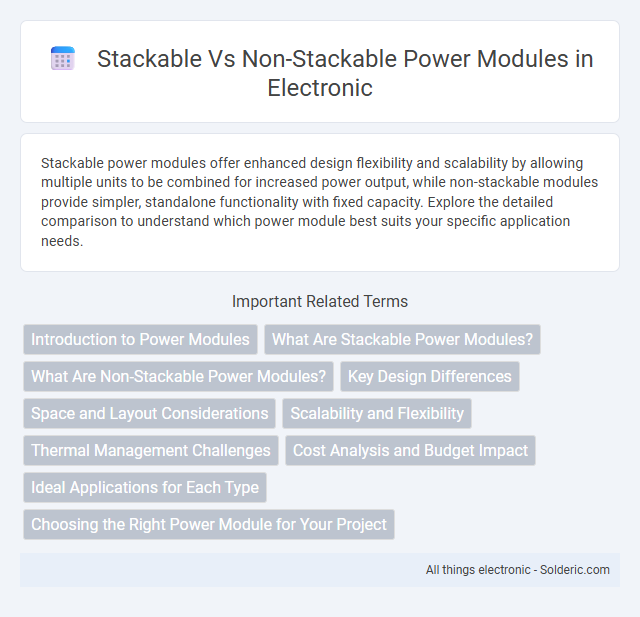Stackable power modules offer enhanced design flexibility and scalability by allowing multiple units to be combined for increased power output, while non-stackable modules provide simpler, standalone functionality with fixed capacity. Explore the detailed comparison to understand which power module best suits your specific application needs.
Comparison Table
| Feature | Stackable Power Modules | Non-Stackable Power Modules |
|---|---|---|
| Design | Modular, can be physically stacked for scalable power | Standalone units, fixed size and capacity |
| Scalability | High, easy to add modules for increased capacity | Limited, requires replacing with higher capacity units |
| Space Efficiency | Optimized, compact footprint due to stacking | Less efficient, larger combined footprint |
| Maintenance | Modular replacement lowers downtime | Entire unit replacement needed |
| Cost | Higher initial, lower long-term upgrade costs | Lower initial, higher upgrade/replacement costs |
| Application | Dynamic, suitable for growing systems | Fixed capacity, suited for stable power needs |
Introduction to Power Modules
Power modules are compact, integrated devices designed to efficiently manage electrical power conversion and regulation in various applications. Stackable power modules offer modular scalability, allowing multiple units to be combined seamlessly to increase power output or functionality without redesigning the system. Non-stackable power modules provide fixed capacity and are optimized for specific power requirements, ensuring simplified integration and consistent performance.
What Are Stackable Power Modules?
Stackable power modules are modular components designed to be vertically integrated or connected side-by-side, enabling scalable power management solutions tailored to varying load requirements. These modules offer enhanced flexibility and improved thermal management by allowing multiple units to share power distribution without compromising efficiency or footprint. Their design supports easy expansion and maintenance, making them ideal for applications demanding dynamic power scaling such as telecom systems, data centers, and industrial automation.
What Are Non-Stackable Power Modules?
Non-stackable power modules are individual power units designed to operate independently without the capability to connect or combine with other modules to increase power output or capacity. These modules are typically used in applications where a fixed power requirement is sufficient, and scalability is not needed. Choosing the right non-stackable power module ensures your system delivers consistent, reliable performance without the complexity of managing multiple interconnected units.
Key Design Differences
Stackable power modules are designed with standardized physical dimensions and interconnects, enabling seamless vertical integration and easy expansion of power capacity. Non-stackable power modules typically have custom layouts tailored for specific applications, lacking uniform connectors, which limits flexibility and scalability. Your choice hinges on whether modular scalability or specialized design efficiency is the priority in your power system architecture.
Space and Layout Considerations
Stackable power modules offer compact space utilization by allowing vertical integration, significantly reducing PCB footprint and enabling more efficient layout designs, especially in high-density applications. Non-stackable modules require lateral placement, increasing board area and complicating heat dissipation strategies due to their spread-out configuration. Designers must carefully evaluate available real estate and thermal management needs when choosing between stackable and non-stackable power modules to optimize both space and system reliability.
Scalability and Flexibility
Stackable power modules enable seamless scalability by allowing multiple units to be connected, supporting growing power demands without extensive redesign. Non-stackable modules offer fixed capacity, limiting flexibility when adapting to future expansion or changing load requirements. Choosing stackable modules enhances your system's adaptability and allows incremental upgrades to match evolving power needs.
Thermal Management Challenges
Stackable power modules often face thermal management challenges due to the increased heat density caused by multiple modules operating in close proximity, requiring efficient heat dissipation techniques such as advanced heat sinks or liquid cooling systems. Non-stackable power modules typically benefit from better airflow and heat distribution, reducing thermal stress on individual components and enhancing reliability. Your design must account for these differences to ensure optimal thermal performance and prevent overheating in high-power applications.
Cost Analysis and Budget Impact
Stackable power modules offer cost efficiency through modular scalability, allowing businesses to add capacity incrementally without large upfront investments, thereby optimizing budget allocation. Non-stackable power modules typically require higher initial expenditure due to the need for full capacity purchase upfront, impacting cash flow and budget flexibility. Evaluating total cost of ownership, including maintenance and future expansion costs, favors stackable solutions for adaptable and cost-effective power management.
Ideal Applications for Each Type
Stackable power modules excel in applications demanding scalability and flexibility, such as telecommunications and data centers where power requirements frequently change. Non-stackable power modules are suited for fixed, stable power needs often found in industrial machinery and medical equipment, where consistent performance is critical. Your system's specific power demands and future expansion plans determine which module type offers the best efficiency and reliability.
Choosing the Right Power Module for Your Project
Selecting the right power module depends on the project's space constraints and scalability needs. Stackable power modules offer modular expansion and efficient power management by allowing multiple units to be layered vertically, ideal for projects requiring increased power capacity or flexible configuration. Non-stackable modules provide a simpler, often more compact solution with fixed power output, suitable for applications with limited expansion requirements or strict size limitations.
Stackable vs Non-Stackable Power Modules Infographic

 solderic.com
solderic.com